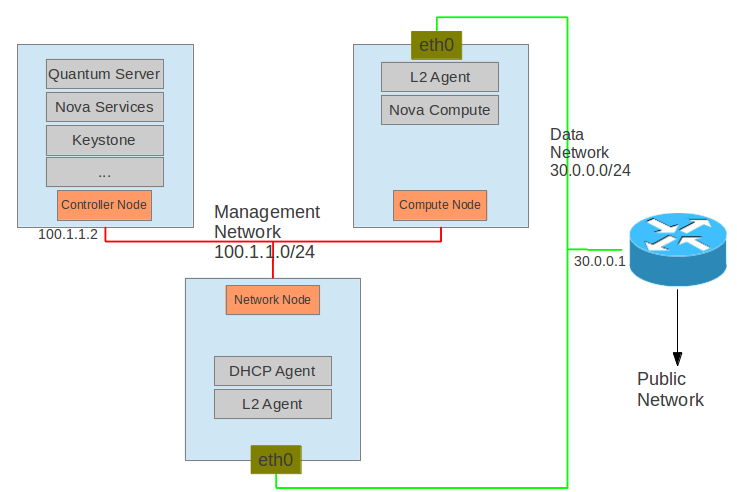This section describes how to install the OpenStack Networking service and its components for a single flat network use case.
The following diagram shows the set up. For simplicity, all nodes should have one interface for management traffic and one or more interfaces for traffic to and from VMs. The management network is 100.1.1.0/24 with controller node at 100.1.1.2. The example uses the Open vSwitch plugin and agent.
![[Note]](../common/images/admon/note.png) | Note |
|---|---|
You can modify this set up to make use of another supported plug-in and its agent. |

The following table describes some nodes in the set up:
| Node | Description | |||
|---|---|---|---|---|
| Controller Node | Runs the Networking service, Identity
Service, and Compute services that are
required to deploy VMs (
|
|||
| Compute Node | Runs the Networking L2 agent and the
Compute services that run VMs (nova-compute
specifically, and optionally other nova-* services
depending on configuration). The node must have at
least two network interfaces. The first
communicates with the controller node through the
management network. The second interface handles
the VM traffic on the data network. The VM can
receive its IP address from the DHCP agent on this
network. |
|||
| Network Node | Runs Networking L2 agent and the DHCP agent. The DHCP agent allocates IP addresses to the VMs on the network. The node must have at least two network interfaces. The first communicates with the controller node through the management network. The second interface handles the VM traffic on the data network. | |||
| Router | Router has IP 30.0.0.1, which is the default gateway for all VMs. The router must be able to access public networks. |
The demo assumes the following prerequisites:
Controller node
Relevant Compute services are installed, configured, and running.
Glance is installed, configured, and running. Additionally, an image must be available.
OpenStack Identity is installed, configured, and running. A Networking user neutron is in place on tenant service with password
NEUTRON_PASS.Additional services:
RabbitMQ is running with the default guest user and password.
MySQL server (user is root and password is root).
Compute node
Compute is installed and configured.

